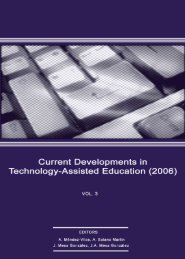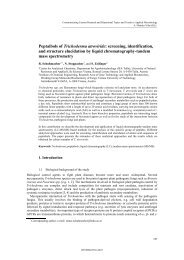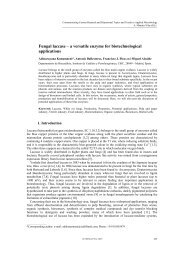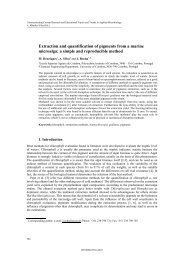Why do food and drink smell like earth? - Formatex Research Center
Why do food and drink smell like earth? - Formatex Research Center
Why do food and drink smell like earth? - Formatex Research Center
You also want an ePaper? Increase the reach of your titles
YUMPU automatically turns print PDFs into web optimized ePapers that Google loves.
have been developed for the actual fungi. Methods for P. expansum are described in [6, 7], <strong>and</strong> similarly<br />
for B. cinerea [35, 36].<br />
9.3 Health <strong>and</strong> safety<br />
An issue which needs to be addressed in this type of work is of a health <strong>and</strong> safety nature. Because of the<br />
know toxicity of fungal secondary metabolites cultures should be <strong>smell</strong>ed for their aroma which is<br />
indefensible in terms of health <strong>and</strong> safety. By analogy, the <strong>smell</strong>ing of grape-juices <strong>and</strong> wines for these<br />
same compounds is surely questionable, <strong>and</strong> requires assessment [15].<br />
10. Conclusions<br />
The production of <strong>earth</strong>y o<strong>do</strong>urs in <strong>food</strong> is a complex subject. In wine the presence of the <strong>smell</strong> can be<br />
considered either detrimental or desirable. Similarly, the rot by B. cinerea can be the notorious grey rot<br />
of grapes or the much sought after noble rot. The <strong>earth</strong>y o<strong>do</strong>ur is complex also with not only geosmin<br />
being involved. B. cinerea produces <strong>earth</strong>y <strong>smell</strong>ing compounds as <strong>do</strong>es P. expansum. The rot by P.<br />
expansum is wholly undesirable as is the production of patulin in grapes <strong>and</strong> products. Also, it produces<br />
geosmin which remains in the fermentation of wines longer than MIB. There is evidence that Botrytis<br />
species can produce patulin <strong>and</strong> this needs to be assessed as this fungus could be the source in grapes <strong>and</strong><br />
products, as could P. expansum. Thus, more research is required to determine which fungus is involved<br />
in patulin <strong>and</strong> <strong>earth</strong>y-<strong>smell</strong> production in grape products. There <strong>do</strong>es not appear to be a link between the<br />
metabolic pathways of geosmin <strong>and</strong> patulin except that they both require sources of carbon but not<br />
nitrogen. Various physical/chemical/biological factors differentially affect geosmin <strong>and</strong> patulin <strong>and</strong> the<br />
respective producing organisms. Geosmin <strong>and</strong> patulin require GC <strong>and</strong> LC methods metho<strong>do</strong>logy<br />
respectively.<br />
Acknowledgements The support of R.R.M. Paterson (grant SFRH/BPD/34879/2007) by Fundação para a Ciência<br />
e a Tecnologia (FCT-Portugal) is gratefully acknowledged.<br />
References<br />
Communicating Current <strong>Research</strong> <strong>and</strong> Educational Topics <strong>and</strong> Trends in Applied Microbiology<br />
_____________________________________________________________________<br />
A. Méndez-Vilas (Ed.)<br />
[1] D.L. Hawksworth, Mycological <strong>Research</strong> 105, 1422 (2001).<br />
[2] J. Burnett, Fungal populations <strong>and</strong> species. Oxford University Press, New York (2003).<br />
[3] R.R.M. Paterson, A. Venâncio <strong>and</strong> N. Lima, <strong>Research</strong> in Microbiology 155, 507 (2004).<br />
[4] R.R.M. Paterson, A. Venâncio <strong>and</strong> N. Lima, Revista Iberoamericana de Micologia 23, 155 (2006).<br />
[5] J.C. Frisvad <strong>and</strong> R.A. Samson, Studies in Mycology 49, 1 (2004).<br />
[6] R.R.M. Paterson, Process Biochemistry 41, 1467 (2006).<br />
[7] R.R.M. Paterson, Journal of Applied Microbiology 102, 1 (2007).<br />
[8] J.C. Frisvad, R.A. Samson, B.R. Rassing, M.I. van der Horst, F.T.J. van Rijn <strong>and</strong> J. Stark, Antonie van<br />
Leeuwenhoek 72, 119 (1997).<br />
[9] J. P. Mattheis <strong>and</strong> R.G. Roberts, Applied <strong>and</strong> Environmental Microbiology 58, 3170 (1992).<br />
[10] S. La Guerche, B. Dauphin, M. Pons, D. Blancard <strong>and</strong> P. Darriet, Journal of Agriculture <strong>and</strong> Food Chemistry<br />
54, 9193 (2006)<br />
[11] C. Karahadian, D.B. Josephson <strong>and</strong> R.C. Lindsay, Journal of Agriculture <strong>and</strong> Food Chemistry 33, 339 (1985).<br />
[12] S. La Guerche, S. Chamont, D. Blancard, D. Dubourdieu <strong>and</strong> P. Darriet. Antonie van Leeuwenhoek 88, 131<br />
(2005).<br />
[13] P. Darriet, D.P. Lamy, S. La Guerche, M. Pons, D. Dubourdieu, D. Blancard, P. Steliopoulos <strong>and</strong> A. Mos<strong>and</strong>l,<br />
European Food <strong>Research</strong> Technology 213, 122 (2001).<br />
[14] G. Lu, C.G. Edwards, J.K. Fellman, D.S. Mattinson <strong>and</strong> J. Navazi, Journal of Agriculture <strong>and</strong> Food Chemistry<br />
51, 1026 (2003).<br />
[15] A.-L. Sunesson, W.H.J. Vaes, C.-A. Nilsson, G. Blomquist, B. Andersson <strong>and</strong> R. Carlson, Applied <strong>and</strong><br />
Environmental Microbiology 61, 2911 (1995).<br />
[16] C.P. Dionigi, D.F. Millie <strong>and</strong> P.B.Johnsen, Applied <strong>and</strong> Environmental Microbiology 57, 3429 (1991).<br />
©FORMATEX 2007<br />
127









